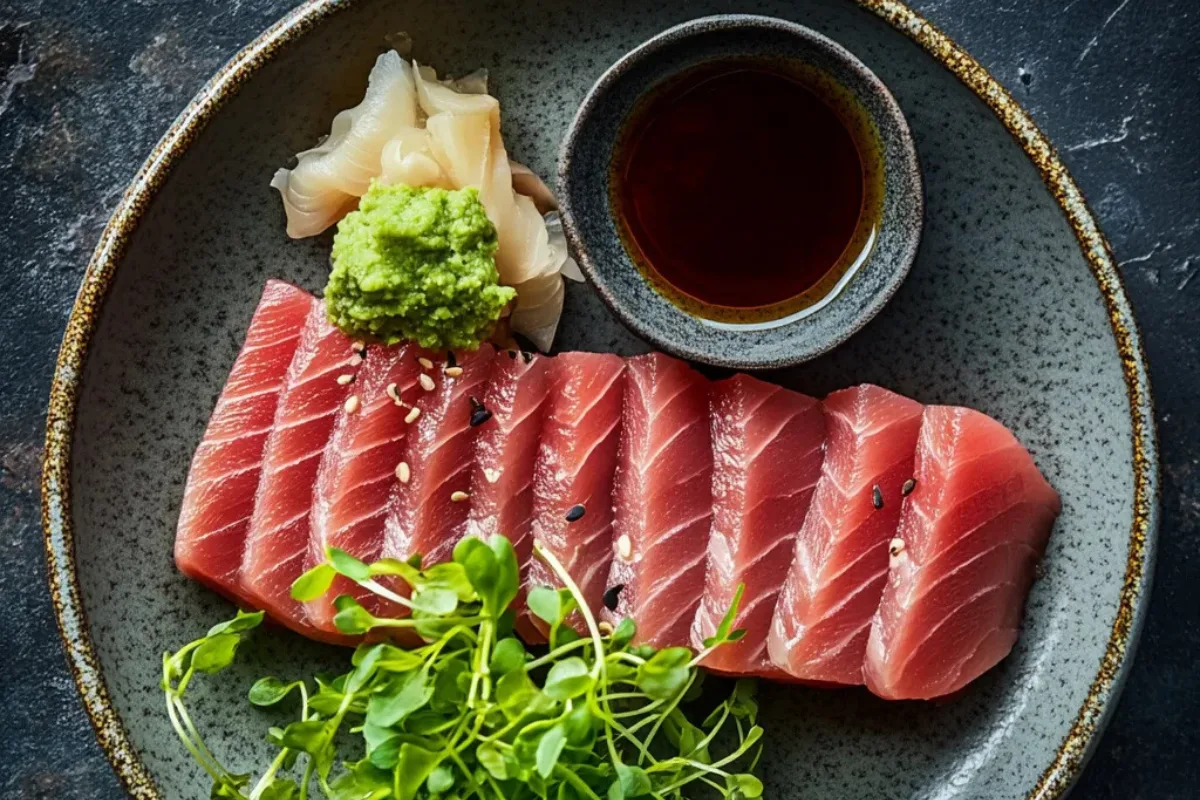Tuna sashimi isn’t just a dish; it’s a cultural masterpiece that bridges tradition and taste. This article dives deep into the fascinating world of tuna sashimi, tracing its origins, exploring the best cuts, and uncovering tips to prepare it like a pro. From its nutritional benefits to its influence on global cuisine, you’ll find everything you need to know about this exquisite delicacy. Whether you’re a sashimi enthusiast or a curious foodie, get ready to indulge in the elegance and artistry of tuna sashimi.
The Origins of Tuna Sashimi
History of Sashimi in Japanese Cuisine
Sashimi, a cornerstone of Japanese culinary art, dates back centuries. Rooted in the Edo period, it emerged as a refined way of serving raw fish, showcasing the natural flavors and freshness of seafood. Tuna sashimi, in particular, became a prized choice due to its velvety texture and robust flavor profile, resonating deeply with the Japanese appreciation for simplicity and purity in food.
Introduction to Tuna as a Sashimi Staple
While many types of fish are used for sashimi, tuna holds a special place. The fish’s versatility allows chefs to craft an array of tastes and textures, from the lean akami to the buttery otoro. Its global appeal isn’t just about taste; it’s about the story behind each slice—highlighting the skill, precision, and care involved in transforming raw tuna into edible art.
Cultural Significance of Tuna in Japanese Cuisine
In Japan, tuna sashimi represents more than food; it’s a cultural icon. Traditionally served during celebrations or shared among close-knit families, it symbolizes prosperity and joy. The practice of meticulously slicing tuna reflects a deep respect for the fish, aligning with Japan’s values of mindfulness and gratitude. Over time, this tradition has captivated the world, making tuna sashimi a global sensation while retaining its roots in Japanese heritage.
Types of Tuna Used in Sashimi
Popular Varieties: Bluefin, Yellowfin, and Bigeye Tuna
When it comes to tuna sashimi, not all tuna is created equal. Three main types dominate the sashimi world: Bluefin, Yellowfin, and Bigeye tuna. Bluefin tuna is often hailed as the king, prized for its rich flavor and marbled fat content. The buttery texture of its otoro (fatty belly) is a delicacy for sashimi lovers.
On the other hand, Yellowfin tuna, also known as ahi, is more commonly available. Its firm, lean meat offers a slightly milder taste, making it a versatile option for those new to sashimi. Lastly, Bigeye tuna strikes a balance, delivering a tender texture and deeper flavor, often compared to Bluefin. Each variety brings a unique taste, texture, and experience to the table.
Comparison of Different Tuna Varieties for Sashimi
So, how do these varieties stack up against each other? Bluefin tuna sashimi often wins in terms of indulgence, but it comes with a hefty price tag. Meanwhile, Yellowfin sashimi is budget-friendly and widely available, offering a cleaner, less intense flavor. Bigeye tuna sashimi provides the best of both worlds, appealing to those who crave a robust taste without breaking the bank. These distinctions highlight why choosing the right type of tuna matters for every sashimi occasion.
Sustainability Concerns and Tuna Populations
While indulging in tuna sashimi is a treat, sustainability is a growing concern. Overfishing of Bluefin tuna has placed significant strain on its population, making it crucial to opt for responsibly sourced fish. Yellowfin and Bigeye are slightly more sustainable but still require careful management. Supporting fisheries with sustainable practices ensures that this beloved dish remains available for generations to come.
What Makes Tuna Sashimi-Grade?
Understanding Sashimi-Grade Standards
The term “sashimi-grade” gets tossed around a lot, but what does it mean? Simply put, it refers to tuna that meets the highest standards of quality and freshness, ensuring it’s safe to eat raw. Tuna sashimi must be handled with exceptional care, from the moment it’s caught to when it’s served. This process includes rapid freezing at ultra-low temperatures to kill parasites and preserve the fish’s pristine condition.
The Importance of Freshness and Quality
Freshness is everything when it comes to tuna sashimi. If the fish isn’t handled properly, it loses its signature texture and flavor. High-quality sashimi-grade tuna boasts a deep red or pink hue, firm flesh, and a mild, clean aroma. A single bite of properly prepared tuna sashimi should melt in your mouth, delivering a rich, umami-packed experience.
How Tuna is Graded: The Process and Criteria
Grading tuna involves a meticulous evaluation of its color, texture, fat content, and overall quality. Experts look for vibrant, evenly colored flesh with no discoloration or dryness. Bluefin tuna sashimi often scores the highest due to its fatty marbling, while Yellowfin and Bigeye are typically graded for their firmness and flavor. This grading ensures that what ends up on your plate is nothing short of exceptional.
Health Benefits of Tuna Sashimi
Nutritional Profile of Tuna Sashimi
Tuna sashimi isn’t just a treat for your taste buds—it’s a powerhouse of essential nutrients. Packed with high-quality protein and omega-3 fatty acids, it supports muscle repair and promotes brain health. A typical serving is low in calories but rich in vitamins B6 and B12, selenium, and magnesium, making it an excellent choice for those seeking a nutritious yet indulgent meal.
Omega-3 Fatty Acids and Their Benefits
The omega-3s in tuna sashimi offer numerous health perks. These healthy fats improve heart health, reduce inflammation, and even support mental clarity. Incorporating sashimi into your diet a few times a week can help maintain a healthy balance of these essential fats, especially if you pair it with other wholesome ingredients like avocado or seaweed.
Tuna Sashimi as a High-Protein, Low-Calorie Option
For anyone watching their waistline, tuna sashimi is a go-to option. With its lean protein content, it helps you feel full longer without piling on extra calories. Whether you’re following a low-carb diet or just trying to eat cleaner, tuna sashimi provides a satisfying way to nourish your body without compromising on flavor.
For more delicious seafood recipes, check out the Ultimate Guide to Sushi Burrito Customization and Toppings.
How to Prepare and Serve Tuna Sashimi
Essential Ingredients for Authentic Tuna Sashimi
Creating authentic tuna sashimi starts with the right ingredients. First and foremost, select sashimi-grade tuna for its guaranteed freshness. Pair it with classic condiments like wasabi, pickled ginger, and soy sauce. To elevate the dish, consider adding slices of avocado, shredded daikon radish, or a drizzle of sesame oil.
Step-by-Step Preparation Techniques
Preparation is an art in itself. Start by patting the tuna dry and placing it in the freezer for 10–15 minutes. This slight firmness ensures precision when slicing. Using a sharp knife, cut against the grain into thin, even slices. Always keep the tuna cold to preserve its texture and freshness. Arrange the slices delicately on a plate for a presentation that’s as elegant as it is appetizing.
Tips for Serving and Presentation
The way you present tuna sashimi can make a big difference. Serve it on a chilled plate or bamboo tray for an authentic feel. Garnish with microgreens or edible flowers for a pop of color. Don’t forget to include small bowls of soy sauce for dipping and optional citrus ponzu for a tangy twist.
For more inspiration on seafood delights, consider exploring this Hawaii Poke Recipe Guide.
The Best Cuts of Tuna for Sashimi
Exploring the Different Cuts: Akami, Chutoro, and Otoro
When it comes to tuna sashimi, the cut of the fish is just as important as its freshness. The three main cuts—akami, chutoro, and otoro—offer unique textures and flavors. Akami, the leanest part, is taken from the sides of the tuna and boasts a firm texture with a deep red color. It’s a perfect choice for those who prefer a lighter, more subtle taste.
Chutoro, a medium-fatty cut from the belly near the skin, offers a balance between leanness and richness. Its pinkish hue and buttery texture make it a crowd favorite. Lastly, there’s the luxurious otoro, the fattiest part of the tuna belly. With its creamy texture and marbled appearance, otoro tuna sashimi melts in your mouth and delivers an unforgettable taste.
How the Cut Affects Texture and Flavor
Each cut of tuna sashimi brings something special to the table. Akami is clean and refreshing, while chutoro combines richness with a hint of firmness. Otoro, with its high-fat content, offers an indulgent, melt-in-your-mouth experience that’s hard to beat. The diversity of these cuts is why tuna remains such a celebrated choice for sashimi enthusiasts.
Choosing the Perfect Cut for Your Preferences
Choosing between these cuts depends on your taste. If you enjoy delicate flavors, akami might be your top pick. For a more balanced bite, try chutoro. But if you’re in the mood to splurge, otoro is the ultimate indulgence.
Tuna Sashimi in Global Cuisine
Influences of Tuna Sashimi Beyond Japan
Tuna sashimi might have its roots in Japan, but its appeal has crossed borders and influenced cuisines worldwide. In Hawaii, it’s a key ingredient in poke bowls, a beloved dish that combines diced raw tuna with seaweed, soy sauce, and sesame oil. In the U.S. and Europe, chefs are incorporating tuna sashimi into fusion dishes like sushi tacos and sashimi salads, blending traditional flavors with modern flair.
Fusion Dishes
The versatility of tuna sashimi makes it a star ingredient in innovative dishes. Sashimi-topped rice bowls, sashimi-grade tuna on avocado toast, or even thin slices draped over pasta bring new dimensions to global dining. These creative takes highlight how tuna sashimi can adapt to various culinary styles while maintaining its elegance.
Tuna sashimi has become more than a dish—it’s a cultural ambassador, bringing the artistry of Japanese cuisine to plates around the globe. Whether served traditionally or with a modern twist, it continues to captivate food lovers everywhere.
FAQs
What is the Best Tuna for Sashimi?
Selecting the best tuna for sashimi depends on both quality and preference. Bluefin tuna is often considered the gold standard due to its rich, fatty cuts like otoro and chutoro. However, Yellowfin and Bigeye tuna are excellent alternatives, offering a firmer texture and milder flavor. The key is to choose sashimi-grade tuna, which guarantees freshness and safety for raw consumption.
How Can You Tell if Tuna is Fresh?
Freshness is vital for enjoying tuna sashimi at its best. Look for tuna with vibrant red or pink hues and firm, moist flesh. Avoid fish with a dull color or overly fishy smell, as these are signs of spoilage. When in doubt, purchasing from a trusted source ensures you’re getting top-quality sashimi-grade tuna.
What are the Risks of Eating Raw Tuna?
While it is generally safe when prepared properly, eating raw fish does carry some risks. Parasites and bacteria can be present in poorly handled seafood. This is why sashimi-grade tuna undergoes freezing to eliminate harmful organisms. Sticking to reputable suppliers minimizes these risks, letting you enjoy your sashimi worry-free.
Conclusion: Why it is a Timeless Delight
From its origins in Japan to its global culinary adaptations, tuna sashimi remains a timeless masterpiece that combines flavor, texture, and artistry. Its versatility shines through in the variety of cuts, each offering a unique taste experience, whether you prefer the clean bite of akami or the luxurious melt of otoro. Beyond its exquisite taste, the dish carries numerous health benefits, making it as nourishing as it is indulgent.
As the world embraces sustainable practices, choosing responsibly sourced tuna sashimi ensures this delicacy can be enjoyed for generations. Whether served traditionally with soy sauce and wasabi or creatively reimagined in fusion cuisine, tuna sashimi continues to delight food lovers across the globe.
At its heart, tuna sashimi isn’t just food—it’s a celebration of simplicity, tradition, and the sea’s bounty. So, the next time you savor a plate of fresh, expertly sliced tuna, take a moment to appreciate the rich history and craftsmanship that goes into creating this remarkable dish. It’s more than a meal—it’s an experience that connects us to both tradition and innovation.

